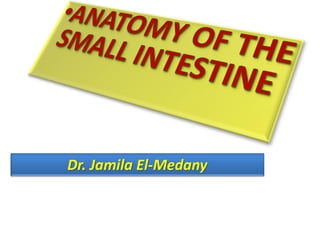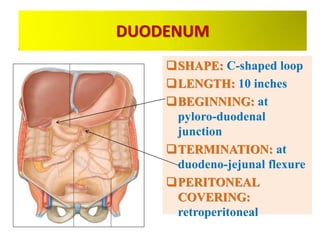5- ANATOMY OF SMALL INTESTINE.pdf
- 2. OBJECTIVES At the end of the lecture, students should: ’ü▒List the different parts of small intestine. ’ü▒Describe the anatomy of duodenum, jejunum & ileum regarding: the shape, length, site of beginning & termination, peritoneal covering, arterial supply & lymphatic drainage. ’ü▒Differentiate between each part of duodenum regarding the length, level & relations. ’ü▒Differentiate between the jejunum & ileum regarding the characteristic anatomical features of each of them.
- 3. Posterior abdominal wall Anterior abdominal wall What is MESENTERY? Loop of intestine
- 4. 1 2 FIXED (Retro peritoneal) PART (NO MESENTERY) DUODENUM FREE (MOVABLE) PART (WITH MESENTERY) JEJUNUM & ILEUM
- 5. DUODENUM ’ü▒SHAPE: C-shaped loop ’ü▒LENGTH: 10 inches ’ü▒BEGINNING: at pyloro-duodenal junction ’ü▒TERMINATION: at duodeno-jejunal flexure ’ü▒PERITONEAL COVERING: retroperitoneal
- 6. PARTS ŌĆó The duodenum is divided into (4) parts: ŌĆó 1st : Superior. ŌĆó 2nd : Descending (vertical). ŌĆó 3rd : Inferior (Horizontal) ŌĆó 4th : Ascending
- 7. LENGTH ŌĆō SURFACE ANATOMY PART LENGTH LEVEL FIRST PART (Superior) 2 INCHES L1 (Transpyloric Plane) SECOND PART (Descending 3 INCHES DESCENDS FROM L1 TO L3 THIRD PART (Horizontal) 4 INCHES L3 (SUBCOTAL PLANE) FOURTH PART (Ascending) 1 INCHES ASCENDS FROM L3 TO L2
- 9. RELATIONS OF FIRST PART X Anterior Liver 1) 2) 3) X Posterior 1)Bile duct 2) Gastroduodenal artery 3)Portal vein
- 10. RELATIONS OF SECOND PART X Anterior )Liver )Transverse Colon )Small intestine Posterior Right kidney Lateral R Colic Flexure Medial Pancreas
- 11. OPENINGS IN SECOND PART OF DUODENUM 1. Common opening of bile duct & main pancreatic duct: on summit of major duodenal papilla. 2. Opening of accessory pancreatic duct (one inch higher): on summit of minor duodenal papilla.
- 12. RELATIONS OF THIRD PART ’ü▒Anterior: a)Small intestine b) Superior mesenteric vessels ’ü▒Posterior: 1) Right psoas major 2) Inferior vena cava 3) Abdominal aorta 4) Inferior mesenteric vessels. 1 2 3
- 13. RELATIONS OF FOURTH PART ’ü▒Anterior: Small intestine ’ü▒Posterior: Left psoas major psoas
- 15. Blood Supply & Lymph drainage ’ü▒ Because the duodenum is derived from both: Foregut & Midgut, ’ü▒ It has its Arterial Supply from : ’ü▒ Celiac & Superior mesenteric arteries. ’ü▒ Venous Drainage to : ’ü▒ Superior mesenteric& Portal veins. ’ü▒ LYMPHATIC DRAINAGE: Celiac & Superior mesenteric lymph nodes.
- 16. JEJUNUM & ILEUM ’ü▒ SHAPE: Coiled tube ’ü▒ LENGTH: 6 meters (20 feet) ’ü▒ BEGINNING: at Duodeno- jejunal flexure ’ü▒ TERMINATION: at Ilieo- caecal junction ’ü▒ EMBRYOLOGICAL ORIGIN: Midgut ’ü▒ Blood SUPPLY: Superior mesenteric A & V ’ü▒ LYMPHATIC DRAINAGE: Superior mesenteric lymph nodes
- 17. JEJUNUM ILEUM LENGTH Shorter (proximal 2/5) of SI Longer (distal 3/5) of SI DIAMETER Wider Narrower WALL Thicker (more plicae circulares) Thinner (less plicae circulares) APPEARANCE Dark red (more vascular) Light red (less vascular) VESSELS High & Less arcades (long terminal branches) Low & More arcades (short terminal branches MESENTERIC FAT Small amount & away from intestinal border Large amount & close to intestinal border LYMPHOID TISSUE Few aggregations Numerous aggregations (PeyerŌĆÖs patches)
- 18. THANK YOU

















